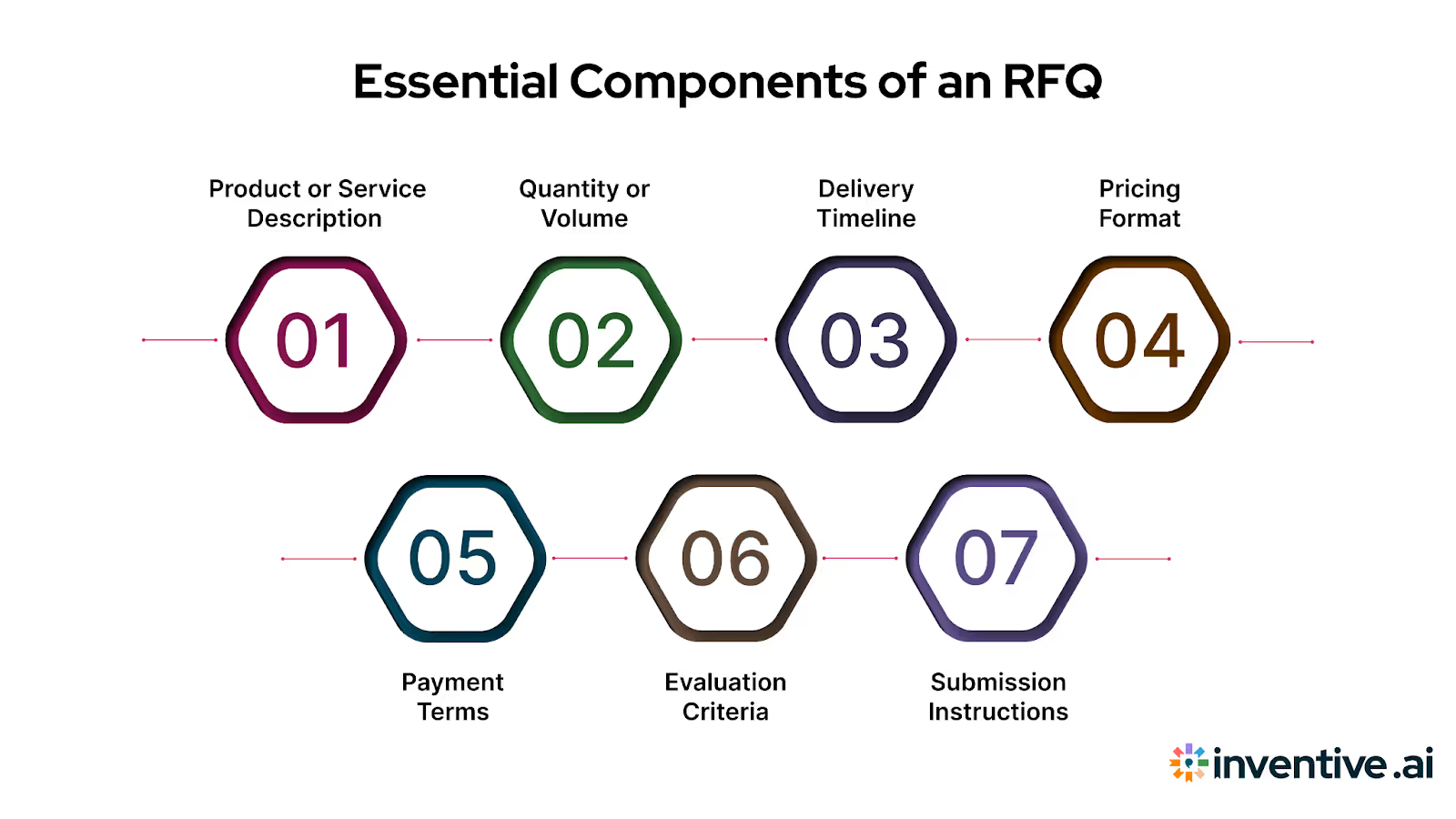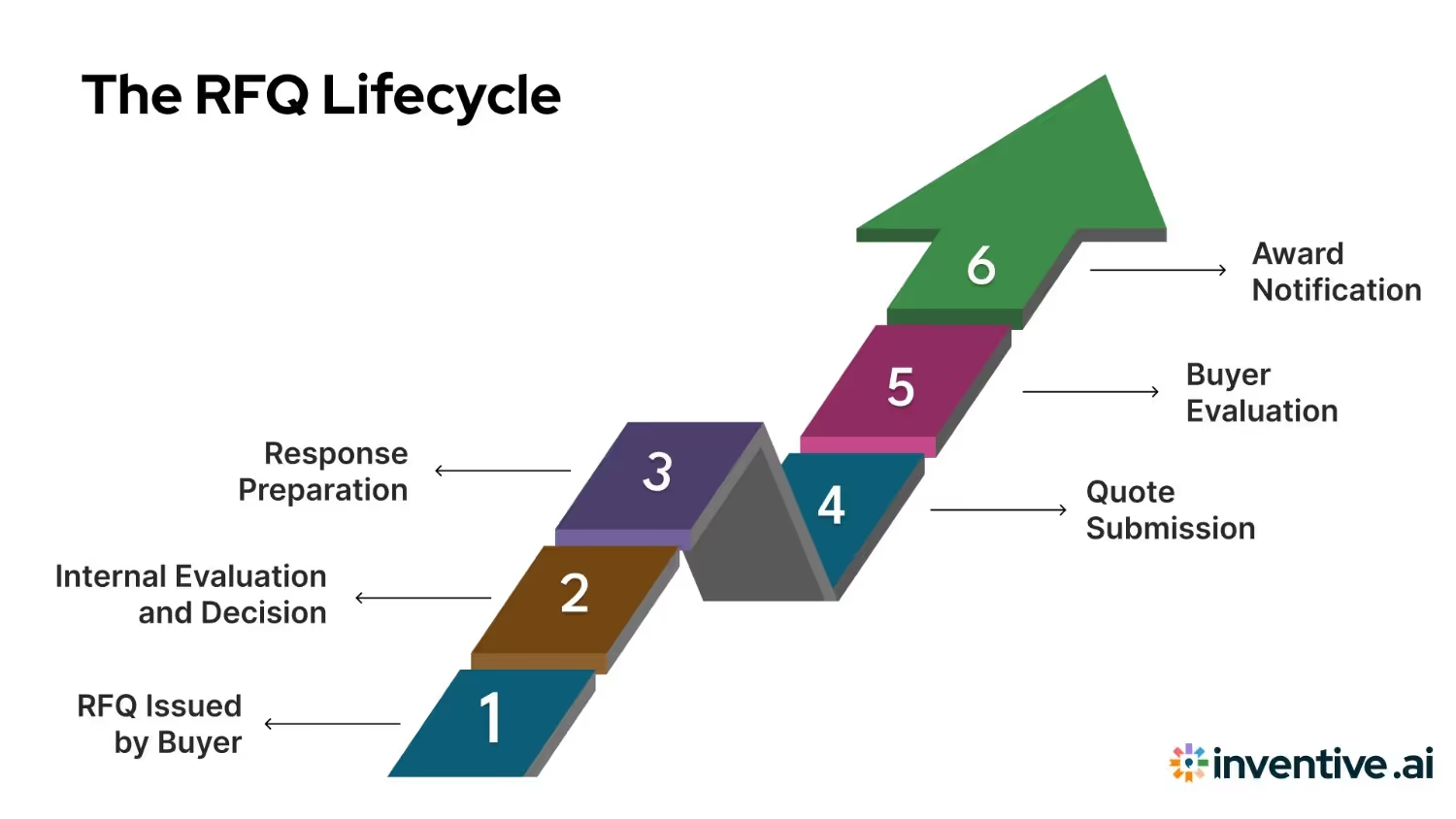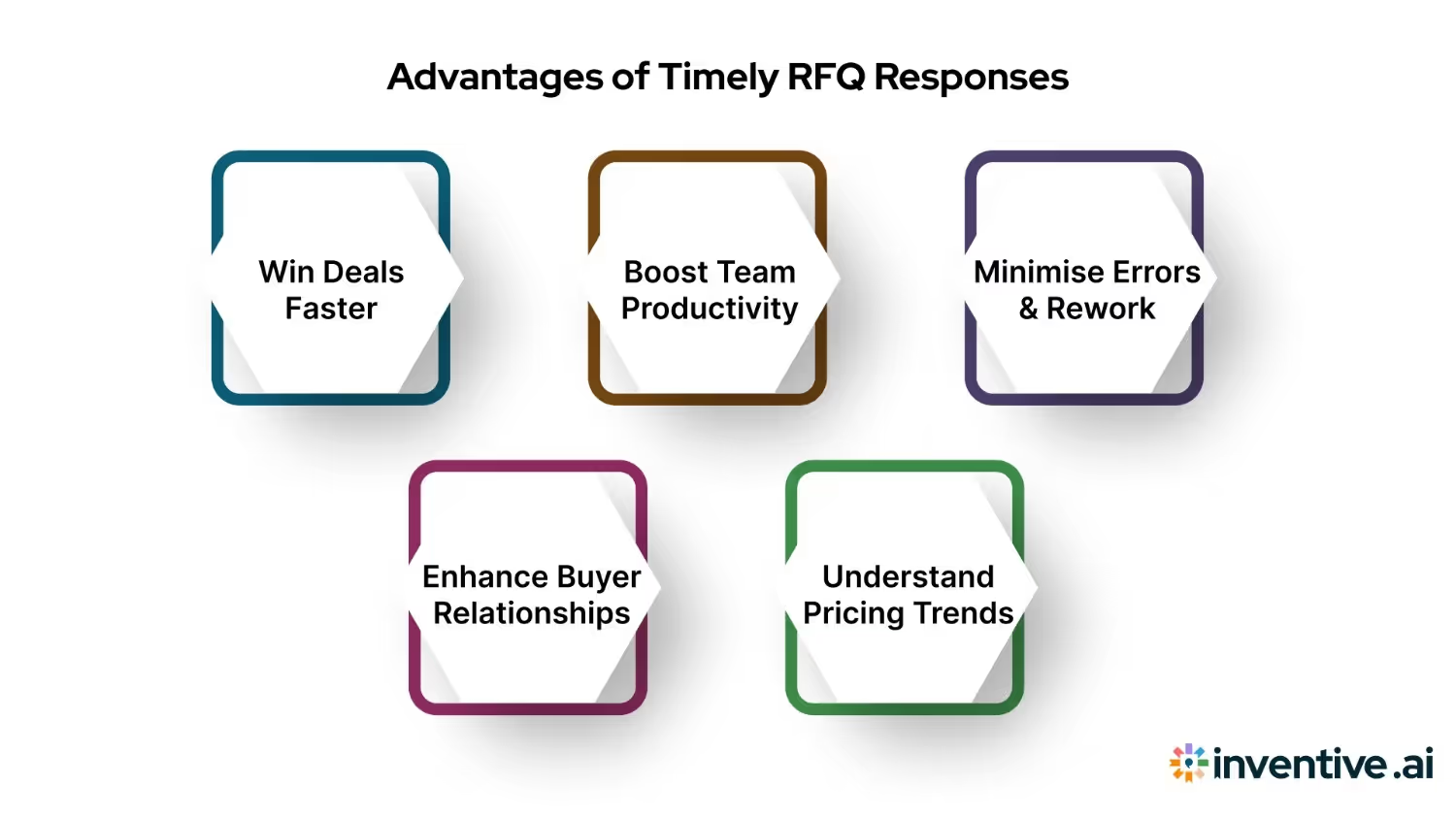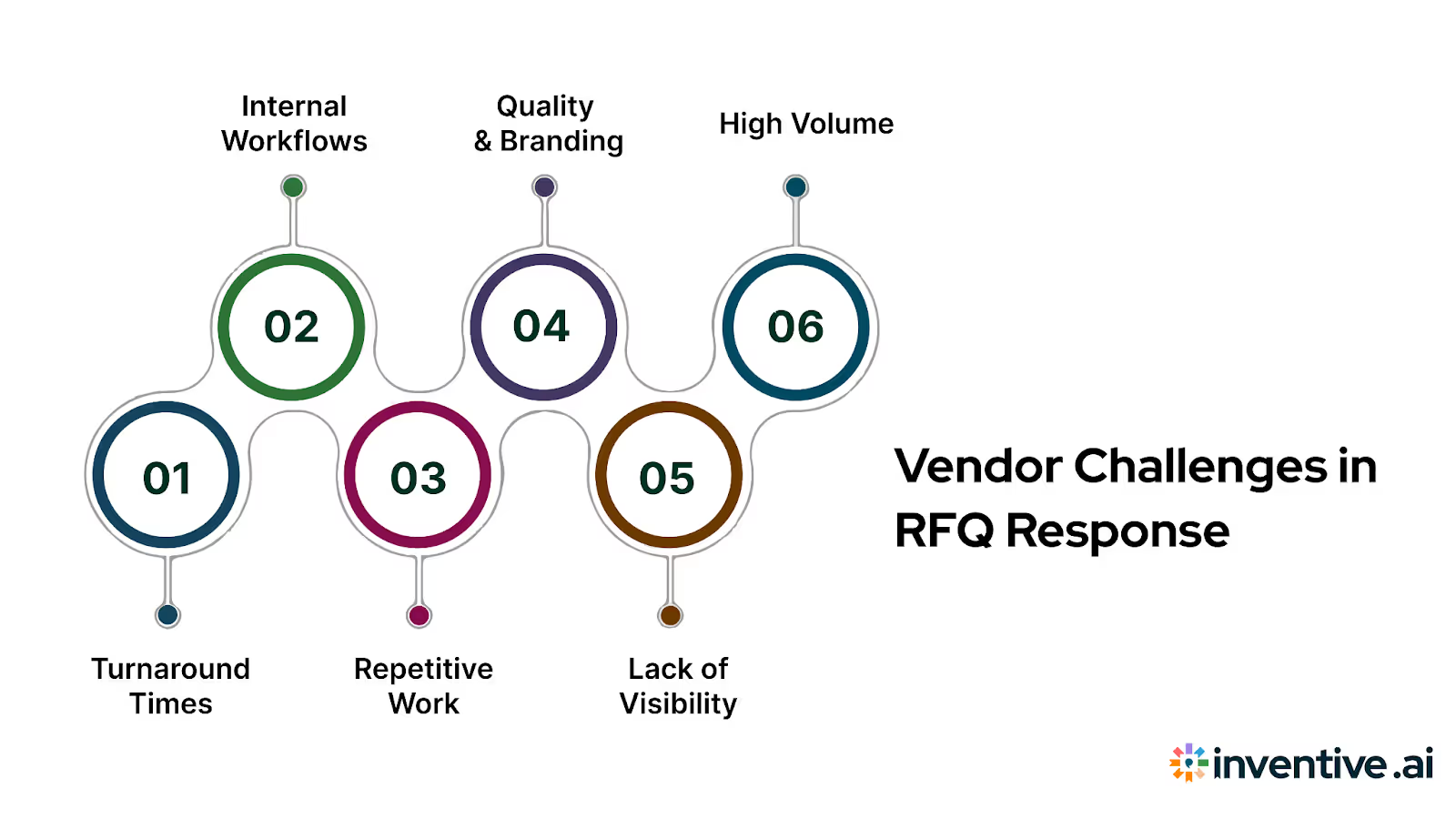Understanding the Request for Quote (RFQ) Process: How to Respond Faster
Understand the RFQ process, from soliciting quotes to comparing offers. Learn strategies to improve response time, ensure accuracy, and enhance procurement efficiency.

Introduction
According to industry analysts, 35–50% of deals go to the vendor who responds first.
That makes speed one of the most decisive factors in winning RFQs, especially when buyers are evaluating near-identical offerings.
For sales and proposal teams, RFQs represent a high-velocity opportunity to close business, but only if your response process is built for efficiency. Unlike RFPs, which focus on strategy and storytelling, RFQs are short, transactional, and highly time-sensitive. And yet, many vendors still rely on fragmented workflows, outdated templates, and last-minute rushes that lead to errors, misalignment, or missed deadlines.
If your team handles multiple RFQs per month, across SaaS, professional services, manufacturing, or logistics, even small delays can mean lost revenue.
In this blog, we’ll break down the RFQ process from the vendor’s perspective: what’s inside a typical RFQ, how to identify winning opportunities, and how to respond faster without compromising accuracy. You’ll also learn how AI-powered automation tools help leading teams cut response times, streamline collaboration, and win more quotes, at scale.
What is a Request for Quote (RFQ)?
A Request for Quote (RFQ) is a document that a buyer sends to vendors to ask for pricing and delivery details for a specific product or service. Unlike RFPs (Request for Proposals), which ask for detailed plans or strategies, RFQs are more straightforward. They focus on price, quantity, timelines, and terms.
For vendors, receiving an RFQ means the buyer already knows what they need and is ready to compare options. RFQs are common in later stages of the buying process or when the product or service is clearly defined and price is the main factor.
Even though RFQs are shorter than RFPs, responding to them still requires speed and accuracy. If you miss a detail, use the wrong format, or reply too late, you could lose the opportunity, especially when multiple vendors are being compared side by side.
Knowing what an RFQ is sets the stage, but to respond effectively, vendors need to understand what information buyers typically include. Let’s break down the key components of a standard RFQ.
RFQ vs. RFP vs. RFI
With the differences in mind, let’s now take a look at the key elements that are present in an RFQ.
Key Elements of an RFQ

Every RFQ usually follows a structured format, with specific details that vendors need to respond to accurately.
Here are the main elements you’ll typically find in an RFQ:
1. Product or Service Description
A clear explanation of what the buyer needs which includes technical specs, materials, features, or service requirements.
Example: “Video editing for a 2-minute product demo, with voiceover and subtitles.”
2. Quantity or Volume
How many units, licenses, or service hours are required. This helps vendors calculate total pricing.
Example: “Five videos per month for 6 months.”
3. Delivery Timeline
The expected delivery date or project timeline. Buyers may list exact dates or timeframes.
Example: “Final delivery required by October 15, 2025.”
4. Pricing Format
Instructions on how to present your pricing i.e, per unit, per hour, or bundled. May include a template to fill out.
Example: “Provide pricing per video, and total cost for the project.”
5. Payment Terms
Details on how and when the buyer plans to pay (e.g., on delivery, 50% upfront, net-30).
6. Evaluation Criteria
The factors buyers will use to compare responses such as price, timeline, past experience, or vendor reputation.
Example: “Quotes will be evaluated on cost, delivery time, and past work in the retail industry.”
7. Submission Instructions
Guidelines on where and how to send your response. This includes deadlines, contact info, and required formats.
Example: “Submit PDF quote by email no later than 5 PM EST, August 10, 2025.”
Always follow the RFQ instructions exactly. Small mistakes, like missing a required document or using the wrong format, can disqualify even the best-priced quote.
Once you know what to look for in an RFQ, it’s equally important to understand how different bidding models impact how you respond. Here's a look at the most common types of RFQ processes vendors encounter.
Step-By-Step Creation of an RFQ
Here is a step by step process of creating an RFQ -
1. Clearly Define What You Need
Start by outlining exactly what product or service you're seeking. This includes quantity, technical specifications, functional requirements, or preferred brands. The more specific your description, the better vendors can price and fulfill your needs accurately. Avoid vague language. Clarity helps eliminate back-and-forth and misquotes later.
2. Outline Scope and Requirements
In this section, detail the operational or delivery requirements. For example, if the product must meet certain safety standards, be delivered by a specific date, or installed on-site, those should be listed. Mention the location of delivery, packaging instructions, installation needs, or any post-delivery support expected. This step ensures vendors factor all variables into their pricing.
3. Establish Evaluation Criteria
Let vendors know how you plan to evaluate the quotes. While cost is often the primary factor, you may also weigh turnaround time, warranty terms, vendor experience, customer service, or past performance. By sharing your evaluation criteria, you help vendors prioritize what matters most to your team and tailor their proposals accordingly.
4. Set Submission Guidelines
Define the format and deadline for responses. Specify where and how vendors should submit their quotes (email, portal, PDF, etc.), and what must be included i.e., pricing breakdowns, product details, payment terms, or tax information. This creates consistency in responses, making your comparison process easier and faster.
5. Distribute the RFQ
Once your RFQ document is ready, send it to pre-vetted vendors or publish it on your procurement platform. Ensure all vendors receive the same version with identical information and deadlines. This maintains fairness and transparency while allowing you to track responses effectively.
6. Review Quotes and Clarify if Needed
After the submission deadline, gather all responses and evaluate them using your pre-defined criteria. If parts of a quote are unclear or incomplete, don’t hesitate to follow up with vendors for clarification. This avoids miscommunication and helps you make an informed choice.
7. Award the Contract and Notify All Vendors
Once you've chosen the best-fit vendor, notify them formally and proceed with contract negotiations. It's also a best practice to notify other vendors that they weren’t selected, ideally with a polite thank-you for their effort. This maintains goodwill and keeps doors open for future opportunities.
Now that you understand how to create an RFQ, it’s equally important to know what happens after it’s sent out. Let’s walk through the RFQ lifecycle i.e., what vendors should expect at each stage and how to stay competitive throughout the process.
The RFQ Lifecycle: What Vendors Should Expect?

Understanding the RFQ lifecycle helps vendors anticipate what happens at each stage, from the moment an RFQ is issued to when a quote is accepted (or not). While every organization may have its own process, most RFQs follow a similar path. Knowing this flow can help your team respond faster, avoid missteps, and improve win rates.
1. RFQ Issued by Buyer
The buyer identifies a need and sends out the RFQ, either publicly (open) or to a list of invited vendors. This document includes product/service specs, quantities, timelines, and pricing format.
What to do: Quickly assess if the RFQ is a good fit based on capacity, pricing strategy, and past experience. Log it immediately in your response pipeline.
2. Internal Review and Go/No-Go Decision
Your sales or proposal team reviews the RFQ requirements to decide whether to pursue the opportunity. Factors may include deadline, budget fit, contract terms, and competitiveness.
What to do: Establish a fast internal review process so you don’t lose time. Many winning quotes are submitted within the first 48 hours.
3. Response Preparation
Once approved, your team gathers pricing, delivery schedules, past project examples (if requested), and any required documentation. Proposal managers may coordinate with sales, ops, and legal teams.
What to do: Use a central knowledge hub or AI-powered tool to pull from pre-approved templates and past responses to speed up drafting.
4. Quote Submission
As directed by the buyer, the finalized quote is sent in, usually via email, a procurement portal, or a bidding platform. Since submissions are usually final, precision is important.
What to do: Double-check all submission details. Check format, file type, deadline, and contact person. One small error can disqualify your quote.
5. Buyer Evaluation
The buyer compares submissions based on their stated criteria (usually price, delivery time, and vendor qualifications). This may take days or weeks depending on the organization.
What to do: Follow up if appropriate, especially if it's a closed or invited bid. In some cases, buyers may request clarifications or a revised quote.
6. Award Notification or Feedback
The selected vendor receives the purchase order or contract. Others may get a rejection or no response. Some buyers provide feedback upon request which you should take advantage of.
What to do: If you didn’t win, ask for feedback. Use it to improve your next RFQ response. If you won, document the process and materials for reuse in future bids.
Understanding the lifecycle is key. But it’s also important to know how your RFQ strategy should shift depending on the procurement method. Next, we’ll compare RFQs with RFPs so you can fine-tune your response tactics.
Benefits of Responding to RFQs Efficiently

Responding to RFQs may seem routine, but how efficiently your team handles them can make a big difference in your revenue pipeline. When done right, RFQ responses aren’t just about submitting quotes, they’re about gaining competitive advantage, building buyer trust, and scaling deal flow without overloading your team.
Here are the key benefits of responding to RFQs with speed, accuracy, and consistency:
1. Win More Deals by Being First
According to industry research, 35–50% of deals go to the vendor who responds first. In fast-moving RFQ processes, speed directly impacts win rates.
Faster responses put you ahead of slower competitors, especially when buyers are shortlisting the first few quotes they receive.
2. Improve Team Productivity
A repeatable RFQ process reduces time spent recreating documents, chasing internal approvals, or formatting responses. This frees up sales and proposal teams to focus on more strategic deals.
Efficient workflows = less burnout, better turnaround, and more RFQs handled without increasing headcount.
3. Avoid Costly Errors and Rework
When teams rush or work manually, it’s easy to miss key details. This includes incorrect pricing, delivery mismatches, or missing attachments. A streamlined RFQ process helps avoid these mistakes.
Accuracy leads to cleaner submissions, fewer client revisions, and a better impression of professionalism.
4. Strengthen Buyer Relationships
Responding quickly and clearly signals reliability. Even if you’re not the lowest bidder, professionalism and responsiveness build trust, which increases your chances of being invited to future RFQs.
Efficient responses help turn one-off quotes into long-term vendor relationships.
5. Gain Insights Into Pricing Trends
A centralized RFQ response system helps you track what wins, what doesn’t, and how competitors are pricing similar projects. Over time, this can sharpen your pricing strategy.
Efficiency creates room for analysis, helping your team refine its approach across future RFQs.
The faster and more accurately you respond to RFQs, the more likely you are to win, and the easier it becomes to scale without overloading your team.
While the benefits are clear, getting there isn’t always easy. Let’s take a look at the most common challenges vendors face when trying to respond to RFQs at scale.
Overcoming RFQ Response Challenges: What Vendors Must Know

RFQs may appear simpler than RFPs, but for vendors who manage multiple quotes each week, the pressure is just as intense. With tight timelines, repetitive tasks, and fragmented internal coordination, it's easy to fall into reactive habits that slow down responses and hurt deal outcomes.
Let’s look at the most common pain points vendors face when responding to RFQs, and the proven strategies top-performing teams use to overcome them.
1. Short Turnaround Times
RFQs often come with 24–48 hour deadlines, leaving minimal room for pricing approvals, documentation, or cross-team input. The result? Rushed or incomplete responses that risk disqualification.
Solution: Pre-qualify RFQs quickly using a go/no-go checklist. Prioritize high-value opportunities and avoid spending resources on low-margin or misaligned quotes.
2. Disconnected Internal Workflows
Sales, legal, pricing, and operations often operate in silos, slowing down feedback loops and increasing version control issues.
Solution: Loop in all stakeholders early. Use shared workspaces or proposal collaboration tools to assign roles, track progress, and centralize updates in real-time.
3. Manual, Repetitive Work
Pricing tables, delivery terms, and product specs are often rewritten for every RFQ, even when much of the content overlaps.
Solution: Create a centralized content library with reusable modules. Store standard pricing, service descriptions, and FAQs in one place to accelerate drafting.
4. Inconsistent Quality and Branding
When different team members respond using varied styles and formats, the result is a fragmented brand voice and uneven quality.
Solution: Standardize templates for response formatting and pricing structures. Use modular, fill-in-the-blank templates to maintain consistency and professionalism.
5. No Win/Loss Visibility
Many vendors don’t track which RFQs they win or lose or why. Without data, teams can’t refine their approach or identify patterns.
Solution: Set up a win/loss tracking system. Analyze every outcome to identify trends in buyer preferences, pricing effectiveness, and areas for improvement.
6. High Volume, Low ROI Bids
Not all RFQs are worth responding to, especially when margins are thin or buyer requirements are unclear.
Solution: Automate the qualification process. Focus only on the RFQs that align with your strategy, capacity, and revenue goals.
Following best practices helps, but the real game-changer is automation. Let’s look at how Inventive AI empowers sales and proposal teams to streamline their RFQ workflows and win more business, faster.
How Inventive AI Helps Streamline RFQ and RFP Responses?
RFQs and RFP’s move fast, and if your team is still responding manually, you’re likely falling behind. Whether it’s missed deadlines, formatting errors, or internal approval delays, these bottlenecks are quietly eating into your win rate and stretching your team thin.
But what if you could respond 70% faster, without sacrificing accuracy?
By automating the most time-consuming steps of the RFQ and RFP response process, Inventive AI helps your team focus on what matters most: smart pricing, strategic alignment, and deal execution.
Here’s how Inventive AI transforms your RFQ response workflow -
- Respond 10× Faster Without Starting From Scratch: Inventive AI dramatically reduces time spent on repetitive tasks by auto-generating first drafts based on your approved content library, past submissions, and pricing frameworks. Instead of starting from a blank document, your team gets a response that’s 70–90% complete, customized to the RFQ’s format and buyer expectations. This means your team can meet 24–48 hour deadlines without compromising quality, and stay ahead of slower competitors.
- Scale Proposal Volume by 5× Without Increasing Headcount: As RFQ volumes grow, so does the pressure on sales, presales, and proposal teams. Inventive AI helps you scale effortlessly by enabling smart content reuse, modular response building, and centralized collaboration. This means you can respond to 5× more RFQs without hiring more staff, unlocking more revenue opportunities with the same team.
- Reduce Submission Errors by Up to 80%: Manual RFQ workflows often lead to missed specs, outdated pricing, or inconsistent formatting. Inventive AI’s built-in quality controls automatically flag incomplete, non-compliant, or conflicting content before you submit. So you can expect fewer errors, stronger buyer trust, and less rework or disqualification risk.
- Shorten Internal Review and Approval Cycles by 3×: RFQ responses often stall due to scattered feedback loops and cross-functional delays. Inventive’s collaboration workspace lets teams assign sections, comment in real time, and manage version control, all from a single platform integrated with Slack, Teams, Notion, and SharePoint. This means faster signoffs, smoother handoffs, and no last-minute scrambling.
- Improve Win Rates With Better Strategy and Visibility: Inventive AI doesn’t just help you respond. It helps you improve. Built-in analytics show you what content gets reused most, how fast your team is responding, and what’s driving wins. Over time, this data becomes your competitive edge. So, you don’t just scale responses, you scale results.


Here’s what that means for RFQ-driven sales teams:
- Respond up to 10x faster with automated first drafts and smart content reuse.
- Handle 5x more RFQs without increasing headcount or overloading proposal teams.
- Improve consistency and win rates by submitting accurate, on-brand responses every time.
Conclusion
RFQs may be short and straightforward. But in high-volume sales environments, responding to them at scale is anything but simple.
Buyers expect fast, accurate, and well-structured responses. For vendors, that means more than just plugging in numbers. It means aligning across pricing, sales, operations, and legal, all under tight deadlines. Missed specs, version conflicts, or even minor formatting issues can cost you the deal.
That’s why top-performing vendors are rethinking how they handle RFQs.
With Inventive AI’s AI-Powered RFP Response Software, proposal teams gain the speed, structure, and insights they need to respond faster and smarter. From auto-generated drafts to reusable pricing templates and real-time collaboration, Inventive AI helps vendors move from reactive to scalable, without sacrificing accuracy or burning out internal teams.
FAQs
1. How do I know if an RFQ is worth responding to?
Use a quick internal checklist to evaluate:
- Does the scope match our offering?
- Is the budget range feasible?
- Have we worked with this buyer before?
- Do we have a competitive edge (speed, price, track record)?
Not every RFQ is worth pursuing. A fast “go/no-go” process helps prioritize high-fit opportunities and conserve team bandwidth.
2. What happens after I submit an RFQ?
Typically, the buyer will:
- Review all submitted quotes
- Compare pricing, delivery timelines, and vendor qualifications
- Select one or more vendors for further negotiation or immediate award
In most cases, you won’t receive detailed feedback unless requested. That’s why clarity, accuracy, and compliance are critical upfront.
3. How should I handle RFQs that don’t include enough detail?
If requirements are vague, don’t guess. Instead:
- Ask clarifying questions (if contact info is provided)
- Include clear assumptions in your quote (“This pricing assumes X quantity and Y delivery timeline.”)
This shows professionalism and protects you from scope surprises later.
4. Can I negotiate after submitting an RFQ?
Sometimes, especially in invited or repeat vendor scenarios. However, most buyers use RFQs to compare firm offers, so your submission should reflect your best realistic pricing. If revisions are allowed, they’re typically buyer-initiated.


